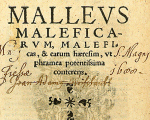 Originally posted on :
Originally posted on :
How do Historians Account for the Comparative Differences in Witch Hunting and the Witchcraze Throughout Europe?
 Title page of the seventh Cologne edition of the Malleus Maleficarum, 1520 (from the University of Sydney Library)
Title page of the seventh Cologne edition of the Malleus Maleficarum, 1520 (from the University of Sydney Library)
The witchcraze was a period in the sixteenth and seventeenth centuries where so-called ‘witches’ were hunted and punished for practising witchcraft. This belief in witchcraft was most noticeable in Scotland and continental Europe as this is where the majority of accusations took place.[1] This essay will look at several different areas of witchcraft and the witchcraze, including where beliefs did and did not take hold, the proportion of men and women who were accused, the influence of the Protestant Reformation and the prosecution of witches across Europe. Historians tend to agree that the witchcraze took off in Protestant areas more than Catholic areas, and also that it was largely female-identified. Historians also agree that there…
View original 3,017 more words


Published on August 15, 2015 14:35
